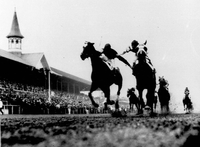Bits
The Snaffle
There are many different bits available, each designed to have a different amount and type of control on the horse. The snaffle bit is a simple design and the most commonly used bit. Although it has variants in its 'family' it basically consists of a metal jointed bar with large rings at either end.

How it Works
The bridle will be adjusted so that it holds the bit in the gap between the horse's front and rear teeth. In this position it will rest against the skin covering the inside of the lower jaw called the bars.
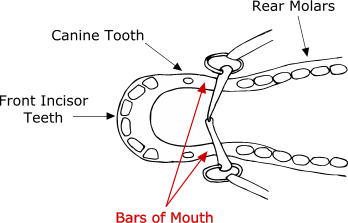
When you pull on the reins, because of the joint in the snaffle bit, it acts like a nutcracker and applies pressure on the horse's lower jaw. This can be quite a severe action so be thoughtful of being gentle on the reins. (The acquiring of the 'feel' of the reins will take some time to get.) Control is also effected by the bit putting pressure on the corners of the lips of the horse.
www.newrider.com/Starting_
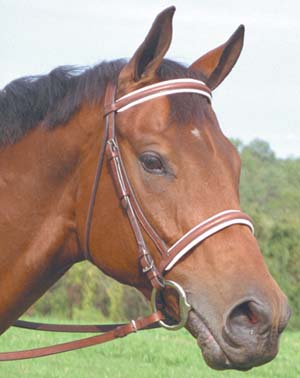 | 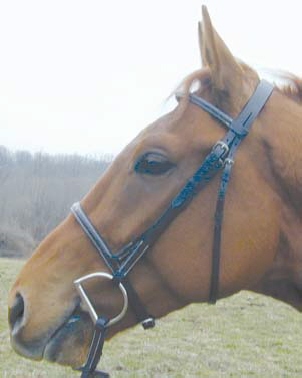 |
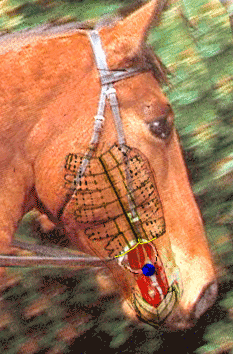
Subject: Positioning The Bit
Author : From the Archives of Jessica Jahiel's Horse-Sense Mailing List
Internationally-acclaimed clinician Dr. Jessica Jahiel is the author of the award winning book for adult working riders, "RIDING FOR THE REST OF US: A Practical Guide for Adult Riders", as well as "The Horseback Almanac", "The Parent's Guide to Horseback Riding" and "The Complete Idiot's Guide to Horseback Riding". Read more about Jessica's books in the Books section of the Gift Barn! Dr. Jahiel teaches dressage, jumping and Holistic Horsemanship,, an all-encompassing approach to horse and rider, emphasizing Communication, Cooperation, Balance and Harmony. The following article is an excerpt from Jessica's subscriber-supported Horse Sense Mailing List. Contact information can be found at the end of the article.
From: Melanie
Hi Jessica, I have been wondering about this question for awhile. It seems like a lot of people determine where to position the bit based on the number of wrinkles in the side of the horse's mouth. I don't see why every horse with all the different types of teeth set, mouths, noses etc. should have the bit placed just based on the number of wrinkles that appear in the corner of ifs mouth. What am I missing here?
Also, I have seen some people let the bit hang loosely, almost where it can hit the front teeth, and see where the horse naturally would want to carry the bit itself, and then adjust the bridle so the bit is carried in that place. That seems more logical to me. Do you see any problems with this method? Would it matter as to where you would want the bit if you wanted contact, such as in dressage, versus non contact, such as in Western Pleasure?
If you don't mind answering one more, somewhat related question :)? I am wondering why the flash is used? I mean, I know it is used to keep the horse's mouth shut and I guess, so it won't fry to get its tongue over the bit etc. But if the horse is trying to do that, isn't something usually bugging it, like the way the rider is riding, or the way the bit feels, or maybe it needs dental work etc.? I would appreciate knowing your thoughts on this. Thanks in advance, Melanie
Hi Melanie! Your instincts are very good, and you are right. It makes perfect sense to adjust the bit to make the horse able to carry it in comfort!
When it comes to snaffles, I'm not sure where this "wrinkle" idea came from - it's recent, and we would do well to get rid of it. It's a fad and a fashion, like the bearing rein (remember "Black Beauty"?) and just as (non)functional. You see those wrinkles everywhere, especially in certain major tack catalogues where there seems to be a full-color photo of a bridled horse on every page, ALWAYS with the bit far too high and the noseband far too tight.
Not so terribly long ago, a snaffle was said to be positioned correctly if it just touched the corners of the horse's mouth - it didn't have to be jammed up into them, and there was no "wrinkle" formula to follow. This is where I would begin with any bit, moving it up or down slightly according to the horse's comfort level and response.
With a young horse that's just learning to carry a bit, it's preferable to adjust it a little high in his mouth, so that he doesn't manage to get his tongue over it. This typically happens with young horses when their bits are adjusted too low. Not only is this uncomfortable for the horse, but putting the tongue over the bit can become a habit, and it's a very difficult habit to break. And like any bad habit, it's better prevented than cured.
Horses should have their teeth checked before they ever have a bit put into their mouths, and they should continue to have their teeth checked at regular intervals for the rest of their lives. Eating can be compromised if a horse's teeth need floating, and so can a horse's mouth comfort! A bit and noseband can become instruments of torture in the mouth of a horse with sharp edges and hooks on its teeth, and even the simplest, gentlest, mullen-mouth or French-link snaffle can cause acute pain to a horse that still has its wolf teeth.
A bit can rub the skin in the corners of the horse's mouth (you can prevent this by applying a little Vaseline). A bit can pinch the horse's lips against the outside edges of its teeth -- no problem if the teeth are smooth, but terribly painful if they have sharp edges. When you check your horse's teeth, check the inside of his mouth as well, including the insides of his lips and cheeks. Sores and ulcers are all too common.
The bit itself can be at fault, either in terms of design, suitability, or condition. Some bits are inherently unkind, and should not be used. Other, inexpensive ones, can be rough or pitted, and cause sores. Perfectly good-quality bits may be too small or too large for a particular horse, or may simply be unsuitable for that horse's mouth conformation.
The French-link snaffle is about as near as I have found to a "one-size-suits-all" bit, and even so, some horses simply go better in a KK snaffle with the different cannon configuration and the lump in the center! In order to choose the right bit, you need to know about bits, and you need to know your horse - does he have a short mouth, a long mouth, a high palate, a low palate, a thin tongue, a thick tongue? How old is he - does he need his wolf teeth removed? Is he retaining tooth caps? Do his teeth need floating? It's really just consideration, and common sense. Choose a bit for your horse with the same attention and care that you would give to selecting a comfortable pair of shoes for yourself! ;-)
As for the Flash noseband - anyone who has ridden with me in a clinic knows that the first thing I generally do is remove the flash attachment and loosen the cavesson. Riders need to distinguish between goals of schooling and goals of showing - schooling means looking for problems and fixing them, whereas showing means finessing the problems and showcasing what you do best.
The flash noseband was invented by someone who wanted to combine the features of the dropped noseband, which ties the horse's mouth shut, with the ordinary cavesson, which serves as an anchor for a standing martingale. You can't put a standing martingale on a dropped noseband. The flash is a very popular item just now, and in some areas it's difficult to find a bridle that doesn't come with a flash! But this is a fad, and as soon as everyone has bought a bridle with a flash, the fashion will almost certainly change in time for all of us to buy new bridles...
Tying the horse's mouth shut may be advantageous when showing, although I think NOT (more about this in a moment), but it is definitely counter-productive when one is schooling. If the horse is opening its mouth, it is almost certainly doing this as a REACTION to something: the bit, the rider's hands, or discomfort elsewhere. A good rider will want to know what the horse is feeling, and will want to do something to make the horse comfortable if he isn't comfortable. A horse can't learn when it it tense or in pain, and it certainly can't enjoy itself. And whether you are schooling or showing or just hacking out, you should care, very much, whether your horse is comfortable and enjoying himself.
A tight noseband of any kind is uncomfortable for the horse, and it seems very silly for riders to insist on tying the horse's mouth tightly shut when one of their goals is to get the horse to relax his jaw! Horses can't relax in the jaw, or at the poll, or in the neck or back, when they are stiffening their jaw in reaction to a tight noseband. Try this yourself: as you read this, tense your jaw, then while KEEPING it tense, try to relax your neck muscles and those in your upper back. You can't do it!!!! No human can - and neither can a horse.
Again, just use your common sense. If you know it isn't possible to relax the neck and back when the jaw is stiff, don't put your bridle on in a way that causes your horse to have a stiff jaw. ;-) If your bit is riding comfortably in the horse's mouth, and the cavesson is adjusted loosely so that the horse can flex comfortably, you will both enjoy your rides much more. ;-)
Copyright © 1996 by Jessica Jahiel, jjahiel@prairienet.org. All Rights Reserved.
Horse-sense mailing list materials may be distributed and copied for personal, non-commercial use provided that all authorship and copyright information, including this notice, is retained. For more information on the horse-sense mailing list, send e-mail to listproc@prairienet.org with the message text: info horse-sense or visit Jessica's website at http://www.prairienet.org/jjahiel/
http://www.nickers.com/lasso/positioning.html
Trackback URL : 이 글에는 트랙백을 보낼 수 없습니다
Trackback RSS : http://www.fallight.com/rss/trackback/1359
Trackback ATOM : http://www.fallight.com/atom/trackback/1359
